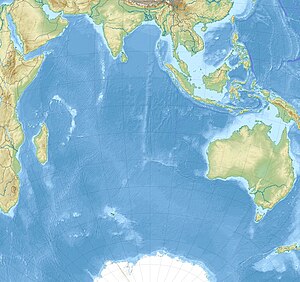Saint Paul Island (French Southern and Antarctic Lands)
| Saint Paul | ||
|---|---|---|
| The island of Saint Paul with the rock La Quille in the foreground | ||
| Waters | Indian Ocean | |
| Archipelago | Saint Paul and Amsterdam | |
| Geographical location | 38 ° 43 '43 " S , 77 ° 31' 33" E | |
|
|
||
| length | 5 km | |
| width | 2.5 km | |
| surface | 7 km² | |
| Highest elevation | Crete de la Novara 268 m |
|
| Residents | uninhabited | |
| main place | Borne du Bougainville (historical) | |
| Map of the island of Saint Paul | ||
The Sankt-Paul-Insel ( French Île Saint-Paul ) [ sɛ̃ˈpɔl ] is an uninhabited, 7 km² large island in the southern Indian Ocean . It has belonged to France since 1892 and is now part of the French Southern and Antarctic Lands (French: Terres Australes et Antarctiques Françaises ).
In 2019, the island was, as part of the -meere French Southern Territories and , for UNESCO World Heritage declared.
geography
The island of volcanic origin lies 92 kilometers south of the Amsterdam Island in the Indian Ocean and is up to 268 m high at its highest point, the Crête de la Novara . The crater-shaped shape of the island is particularly striking, with the northeast flank of the crater slope possibly being blown away by wave erosion or an eruption. The Bassin du Cratère , which is framed by steep slopes , is open to the sea on one side and the natural harbor entrance is only protected by two narrow headlands. There used to be a station for whale and seal hunters here .
history

The Saint Paul Island was probably discovered by the Portuguese in the 16th century , the first mention of it is in 1559. It got its name from Antonio van Diemen , who sailed past the island on July 17th, 1633. The island was first set foot in 1697 by Willem de Vlamingh . It was extensively researched scientifically at the end of 1857 during the Novara expedition . The highest point on the island is still called Crête de la Novara today.
In 1871 the frigate HMS Megaera was leaked off Sankt Paul and deliberately set aground by Captain Arthur Thomas Thrupp (1828–1889) . As a result, most of the crew spent more than two months on the island before the evacuation.
In 1874 there was a French observation station on the island for the transit of Venus on December 9th. A German expedition, which had observed the event from the Kerguelen , visited Saint Paul Island with the SMS Gazelle on February 12, 1875. 24 years later, the participants of the Valdivia expedition also went ashore here. Its director, Carl Chun , saw the wreck of the brig Holt Hill , which was shipwrecked here in 1889 . The first German Antarctic expedition with the research vessel Gauß also visited the island on April 26th and 27th, 1903.
As early as 1893, Saint Paul Island had been taken over for France by the warship L'Eure . In 1928 it was settled by René Bossière, a Breton businessman, with a few dozen sailors. The lobster canning La Langouste Française was put into operation on the crater rim. Due to the bankruptcy of the company in Brittany, the settlers were forgotten and the supply ship L'Austral did not take the survivors back in until two years later.
Wildlife
The island has colonies of the sub-Antarctic fur seal and the northern rockhopper penguin . In addition, numerous seabirds nest here, especially terns and gannets as well as whale birds such as the small duck petrel . The giant squid species Architeuthis sanctipauli is named after St. Paul Island, and a specimen washed up on the island in 1875.
Effect in the literature
The island is the setting for several literary works:
- In his novel The Last Four of St. Paul , Josef Maria Frank deals with the events on the island in the first half of the 20th century.
- also Dorothea Renata Budniok in the youth book Lost on the lobster island .
- Together with its neighboring island, Amsterdam, the island appears in the novel The Children of Captain Grant by Jules Verne .
- The shipwreck of the HMS Megaera finds literary mention in the novel Against the Day by Thomas Pynchon .
- The novel Atlantis Files by Clive Cussler alludes in part to Saint Paul.
- In the crime novel The fine nose of Lilli Steinbeck of Heinrich Steinfest the protagonists discover a secret French Mars station on the island.
See also
literature
- Daniel Floch: Les Oubliés de l'Île Saint Paul. Des Crozet et des Kerguelen . Verlag Ouest-France, Rennes 1993, ISBN 2-7373-1295-7 (French).
Web links
- Île Saint-Paul in the Global Volcanism Program of the Smithsonian Institution (English)
- Francis Lynch: Ile Saint Paul. Photo report in: South Indian Ocean Expedition 2002 (English).
- Bernhard Krauth: General and navigational facts about the islands (Nouvelle) Amsterdam and Saint Paul in the South Indian Ocean . 2016 (excerpts from the updated and updated version of the author's diploma thesis dated February 20, 1995).
Individual evidence
- ^ French Austral Lands and Seas. UNESCO World Heritage Center, accessed July 8, 2019 .
- ↑ Hadoram Shirihai : A Complete Guide to Antarctic Wildlife. The Birds and Marine Mammals of the Antarctic Continent and Southern Ocean. Alula Press, Degerby 2002, ISBN 951-98947-0-5 , p. 173 (English).


